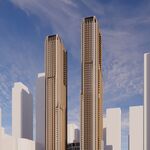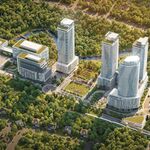I'll actually agree with you on that. I'd think grade-separating Leslie (perhaps just surface but to the south of Eglinton) and elevating the Jane-Weston bit (perhaps extending the tunnel a bit near the current portal) and elevating from Don Mills Road (dropping to the surface under the DVP ... or tunnelling a bit further east) would be sensible. That and reduce the number of stations to speed the line up.
There are many different configurations that could be possible. I think at-grade on the south side of Eglinton between the Laird portal and just east of Leslie, tunnelled from there to Wynford, and then elevated from there to Kennedy would make a lot of sense. Not sure if it would make more sense to run it in-median or along the side of the road. In median may require a minor widening to fit the pillars, but along the side may require some expropriation and re-working of parking lots. Not sure which would be the better arrangement.
Fair enough ... heck, I'd trade Finch West for Hurontario! The Hurontario line has a higher peak load, and almost double the riders as Finch West.
Haha, good call. Overall though, the West ECLRT will be of much greater use to the city at-large than the FWLRT, which is for all intensive purposes a feeder line to the subway. Not that there's anything wrong with that, I just think at this point that trunk lines should take priority.
Still with the forecast peak demand of 4,500 (Metrolinx) then it might not be worthwhile spending half the money for something might be close to capacity ... though TTC estimates are actually lower ... and presumably ridership would drop if it was BRT. I wouldn't oppose proper BRT if it was proposed. But I don't think that's going to happen.
BRT would still be an improvement over the current bus service, that's for sure. And if it does get close to capacity, the beauty is that it would be relatively inexpensive to upgrade a parallel route (or a busy perpendicular route), so that some of the ridership is transferred. This way, not only are you providing enhanced service to new routes, you may also be providing some riders of the existing route with a more efficient way to reach their destination. Doing an upgrade on the same corridor may decrease congestion and marginally increase travel times, but it does nothing for riders on parallel or connecting corridors.
Also, if it's done as proper BRT, theoretically they can upgrade to LRT without having to widen the road ROW at all. This will save on costs later down the road.
And I agree, I don't think a full BRT is going to happen. But hey, even something like queue jump lanes and curbside cut outs would make a difference in the flow of the route.




